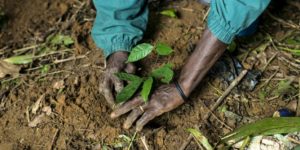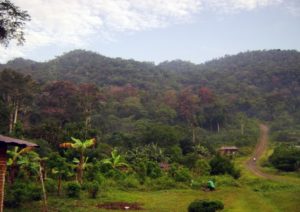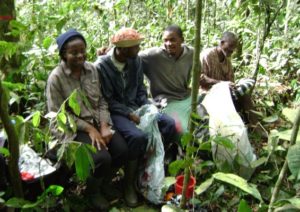
By Kate Evans, originally published at CIFOR’s Forests News
Cameroon – In the south of Cameroon where the Congo Basin meets the Atlantic Ocean, there is a range of hills called the Ngovayang Massif.
Drenched in rain and humidity, the massif is around 1,000 meters high and covered in an ancient forest that ranges from lowland to submontane cloud forest. It is home to gorillas, chimpanzees, panthers, giant pangolins, and porcupines, as well as various rare bird species.
Very little was known about Ngovayang’s plant life until Christelle Gonmadje from the University of Yaounde and the French Agricultural Research Center for International Development (CIRAD) spent five months per year there over the span of her three-year PhD research, listening to gorillas growl and monkeys hoot as she set out 15 one-hectare permanent plots.
Across the Ngovayang Massif, Gonmadje identified 1,491 plant species, including 224 of high conservation value. She found 18 species endemic to this range of hills, which are found nowhere else.
“It is one of the biodiversity hotspots of the world,” she says. “In terms of species richness, it’s very important – perhaps one of the most important sites in Central Africa.”
In collaboration with scientists from a handful of other institutions, including the Center for International Forestry Research (CIFOR), Gonmadje also measured the above-ground biomass in the forest and analyzed its variation with altitude.

Above-ground biomass refers to the total quantity of living matter found in the trees (but not in their roots or the soil). Biomass is crucial to helping scientists and policy makers determine how much carbon is stored in a particular forest.
Gonmadje and colleagues found that in Ngovayang, the above-ground biomass decreases at higher altitudes, driven by a change in the kinds of plants found at different heights.
FORESTS CHANGE WITH ALTITUDE
The study is important, says Terry Sunderland, a senior scientist at CIFOR who also worked on the paper. This is because permanent plot studies in tropical forests have tended to focus on the lowlands.
“What Christelle’s research has shown, is that you can’t make huge generalizations about biomass in tropical rainforest without taking into account the contribution of altitude,” he says.
Environmental conditions vary with altitude – temperature, soil type, rainfall, humidity – and this influences what grows there.
“When you walk from the lowland to the high altitude, some species disappear, because they are not adapted to those conditions,” Gonmadje says. “So the bigger tree species disappear, and you have a shift in species composition.”
Fewer big tree species means less biomass and less carbon – at least above ground. A few other studies have found that at higher altitudes, a higher proportion of a tree’s biomass is stored underground.
Having accurate data on how carbon is stored in forests of different kinds is important for countries like Cameroon that hope to benefit from international efforts to mitigate climate change by reducing deforestation, such as REDD+.

“To be competitive in carbon trading markets or REDD+ initiatives, countries which have tropical forests need to demonstrate that they have reduced their carbon emissions, and that means they need accurate knowledge of the quantity of carbon stock in their forests to start with,” says Gonmadje.
“With this information, policy makers can develop greenhouse gas management and mitigation plans and identify the steps they can take to maintain or increase carbon stocks. You cannot have these benefits if you do not have good, quality data on the biomass and carbon stocks.”
KILLING THE COFFEE
The research also highlights the importance of paying attention to altitude in a warming world.
“As global temperatures change and things get hotter, the altitudinal aspect of tropical ecology is going to play a huge role,” Sunderland says. “What Christelle is showing is basically the importance of plant composition with altitude and how that changes.”
“Coffee, for example, requires a very specific altitudinal and temperature range to grow, and soon it’s going to be too darn hot in the 600 to 1,000-meter range that it is currently grown in, so it’s going to move upward to higher altitudes.”
Many species requiring cooler temperatures will also need to make this shift, he adds. Some, however, won’t be able to adapt and might be lost.
“This will start affecting people everywhere when the price of their coffee goes from the average USD $3 a cup to USD $6. And in the long run, we don’t know which species can adapt, and which will die. It’s going to be a huge problem for many of our agricultural crops. Economically, it’s going to affect us enormously.”
For more information on this topic, please contact Christelle Gonmadje at cgonmadje@yahoo.fr or Terry Sunderland at t.sunderland@cgiar.org.











